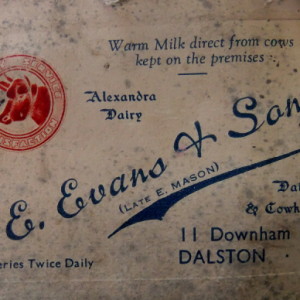The Welsh connection
If you had glanced out of your bedroom window in the early morning 7 or 8 decades ago you would not have been surprised to see a milk cart something like this in the street below.
This one is a toy though, probably dating from the 1930s or 40s. It's been catching my eye in a local antique shop for a while now and today I went in to take some pictures - see extras.
What especially piqued my interest was the authentic, contemporary card attached, advertising a dairy in Dalston, London.
E. Evans & Son (late E.Mason), Dairymen and Cowkeepers, Alexandra Dairy, 11 Downham Rd, Dalston N1. Deliveries twice a day. Warm milk direct from cows kept on the premises.
There's a number of things of interest here. Welsh dairies were an old tradition in London. Many farming families in West Wales had or have London offshoots descended from sons and daughters who went to supply milk to the metropolis in the 19th century and settled there in the strong London Welsh community (with its own chapels and Welsh language social life). Most London dairies bore Welsh names, as did this one. So I wasn't surprised when the man in the shop told me 'a lady had been in who thought she knew the family'.
An old friend of mine, blipped here, now sadly deceased, was the son of a London-Welsh dairyman and in his personal memoir reminisced about accompanying his father on the horse-drawn milk cart through the chilly early-morning streets of Paddington, darting on and off to leave a bottle at every door - and later falling asleep at his school desk as a result. (See photo and description of daily milk deliveries in the 1920s here,.)
Not only did the Evans dairy supply milk, it kept its own cows! This was not an uncommon practice before WW2. There was no refrigeration available so no way of preserving milk. The cows, milked twice daily, were kept in cellars and basements, and fed on cattle cake. If they were lucky there would be a shift system to rotate the animals between outlying pastures but very many spent their entire productive lives in unsanitary backyard conditions, The attendant health risks were very serious: milk was the main vector for childhood TB which was rife until the middle of the 20th century. Strenuous legislation was needed to ensure that dairy cows were tested and milk was pasteurized before sale. (The cow's head logo on the business card bears the caption Purity Service Satisfaction reassuring words that I doubt meant much at all.)
Dalston and Hackney were areas of London that retained extensive pastureland through the centuries so would naturally attract graziers and their animals which wandered freely over the commons. British History Online site carries detailed material on this here and it makes fascinating reading.
"Cowkeepers who had no land suffered from increasingly stringent safeguards for public health. Eighty-three cowsheds and 65 slaughterhouses were inspected in 1876 and 81 cowsheds and 47 slaughterhouses were licensed in 1889; licences had dwindled to 39 and 33 in 1900, to 18 and 21 in 1912, and to 3 and 13 by 1930.....The largest cowkeeper [in Hackney] in 1930 was Edward Mason, with 29 in Downham Road.."
Bingo! The Evans family took over Mr Mason's dairy. I love it when little clues join up with reality. How this old toy is freighted with history!
Extra pics show the old business card and some more aspects of the toy cart, complete with its load of wooden milk bottles (or are they churns?) It must have seemed the obvious plaything for a dairy child to make- believe the daily delivery, just like Tad or Tadcu (Dad or Grandad). Mam and Mamgu probably milked the cows and looked after the shop.




Comments
Sign in or get an account to comment.


